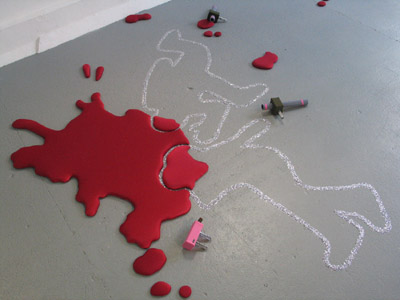 Aftermath, 2004 Installationsansicht Craig Fisher Look Both Ways Click for English text Die erste Ausstellung im neuen Jahr ist dem jungen Briten Craig Fisher (*1976) gewidmet. In seiner ersten Solo Show in der Schweiz zeigt er sein ganzes Spektrum künstlerischen Schaffens. Seine skulpturalen Installationen verblüffen, die Anlehnung an die Comicwelt ist evident. Seien es überdimensionierte Bomben, futuristische Kostüme oder seine eindrücklichen "Blut-Räume", immer schwingt neben der Ironie ein zeitkritisches Statement mit. Nicht nur "Fun-Kultur" interessiert ihn, sondern vielmehr die diskursive Auseinandersetzung mit seiner Umwelt. Die Arbeiten sind alle aufwändig von Hand gefertigte Stücke; eine Affinität zum Textilen ist stets spürbar. Im Grenzbereich zu zeitgenössischer Mode arbeitet er mit Hightech-Materialien wie Neopren, Gore-Tex, Armee-Camouflagen, aber auch mit Leder, Samt und Wolle. Im Zentrum der Thuner Ausstellung steht die Installation "Aftermath", die schon in Grossbritannien für Furore sorgte. Sie besteht aus am Boden liegenden Skulpturen, Überresten eines Massakers: Blutflecken, glitzernde Umrisszeichnungen und achtlos herumliegende Tatwaffen - von den Körpern hingegen fehlt jede Spur. Die Szenerie mutet von der Machart her "comicartig" an - im Kopf etablieren sich aber sofort Verbindungen mit all den mörderischen "Schrecklichkeiten", die tagtäglich vor unseren Augen über die Bildschirme flackern. Die Verniedlichung, die durch das gewählte Material - Pailletten, farbige Stoffe und schöne Stoffapplikationen - erreicht wird, kann nur im ersten Augenblick über die Tiefgründigkeit der Arbeit hinwegtäuschen. Einmal mehr hinterfragt Fisher die Welt - all die Terroranschläge werden unvermittelt sehr präsent - gesehen jedoch durch den Filter vermeintlich "harmloser" Comic-Ästhetik. Eine ergreifende Anordnung, am Puls der Zeit. Seine Wandobjekte, er nennt sie "Walkie-Talkies" sind irgendwo zwischen pseudo-technologischen Science-Fiction-Geräten und Kinderspielzeug anzusiedeln. Minutiös sind die Teile gefertigt, wunderschöne Objekte; jedoch ohne besondere Funktion. Eine Wandmalerei und Zeichnungen auf Papier runden die Ausstellung ab. Sie sind einerseits Skizzen für die Installationen/Objekte, andererseits filigran gefertigte, meist mehrfarbige, autonome Arbeiten. Wie der Titel "Look Both Ways" andeutet, sind seine Arbeiten auf verschiedene Arten zu lesen - als amüsante Comicadaptionen, gleichzeitig aber auch als kritische Auseinandersetzung mit unserer Zeit. Bernhard Bischoff, Februar 2005 Ausstellungsdauer: 20.2. - 2.4.2005 Öffnungszeiten: Mi-Fr 14 - 18 Uhr, Sa 11 - 16 Uhr Galerie Bernhard Bischoff Hofstettenstrasse 6 CH-3600 Thun Telefon 033 221 75 05 Fax 033 221 75 06 Email mail@bernhardbischoff.ch www.bernhardbischoff.ch Craig Fisher Look Both Ways The first exhibition in the new year is dedicated to young British artist Craig Fisher (*1976). In his fist solo show in Switzerland the artist confronts us with the whole spectrum of his artistic world. His sculptural installations are amazing; they quite obviously allude to and imitate the world of comics. But whether the artist constructs oversized bombs, futuristic costumes or one of his impressive "blood rooms" - his irony is never devoid of a critical sentiment. It is not "fun culture" as such that interests him in the first place, but the discursive examination of the wolrd around him. All works are meticulously made by hand; the artist's affinity to textiles cannot be denied. On the threshold to contemporary fashion design he works with high tech materials such as neoprene, gore tex and army camouflage, but also with leather, velvet and wool. As the title "Look Both Ways" indicates, his works are open to various interpretations - they are amusing adaptations of comics and critical examinations of our times at the same time. "Aspiring to boyhood fantasies I often use iconography associated with traditionally "masculine" pursuits such as the soldier, astronaut or sports hero. I make installations, imaginary beings or objects that are androgynous inform. The work is not specifically identifiable as any one thing, be it object or image, craft/fashion or art, furniture or sculpture, gay or straight, happy or sad. The work operates in an indefinable space, somewhere between reality and fantasy. I attempt to question the boundaries between the public and private self. I'm interested in playing with peoples assumptions about what I'm allowed to be as a man and an artist and how masculinity is defined. By suggesting an inferred narrative in the production of each installation and by using references from fashion, film and high and low art I create a space in which the viewer is able to imagine and project their own private fantasies through the exploration of the objects. By making sculpture that refers to clothing / furniture the work looks as if it should be worn or used, but this is never possible, in actual fact the sculptures are always disfunctional. The use of particular utilitarian fabrics highlights this contradiction and it is also essential in creating a juxtaposition between the exclusivity of high fashion and the generic, the everyday. Material, colour, and texture are all integral to the work as a way of blurring the boundaries between the sculptural and pictorial. I want to create something that is familiar and comforting in form as well as strange and perverse. This play off of boundaries is fascinating in its potential to reveal disquieting" (Craig Fisher). February 20 - April 2, 2005 |